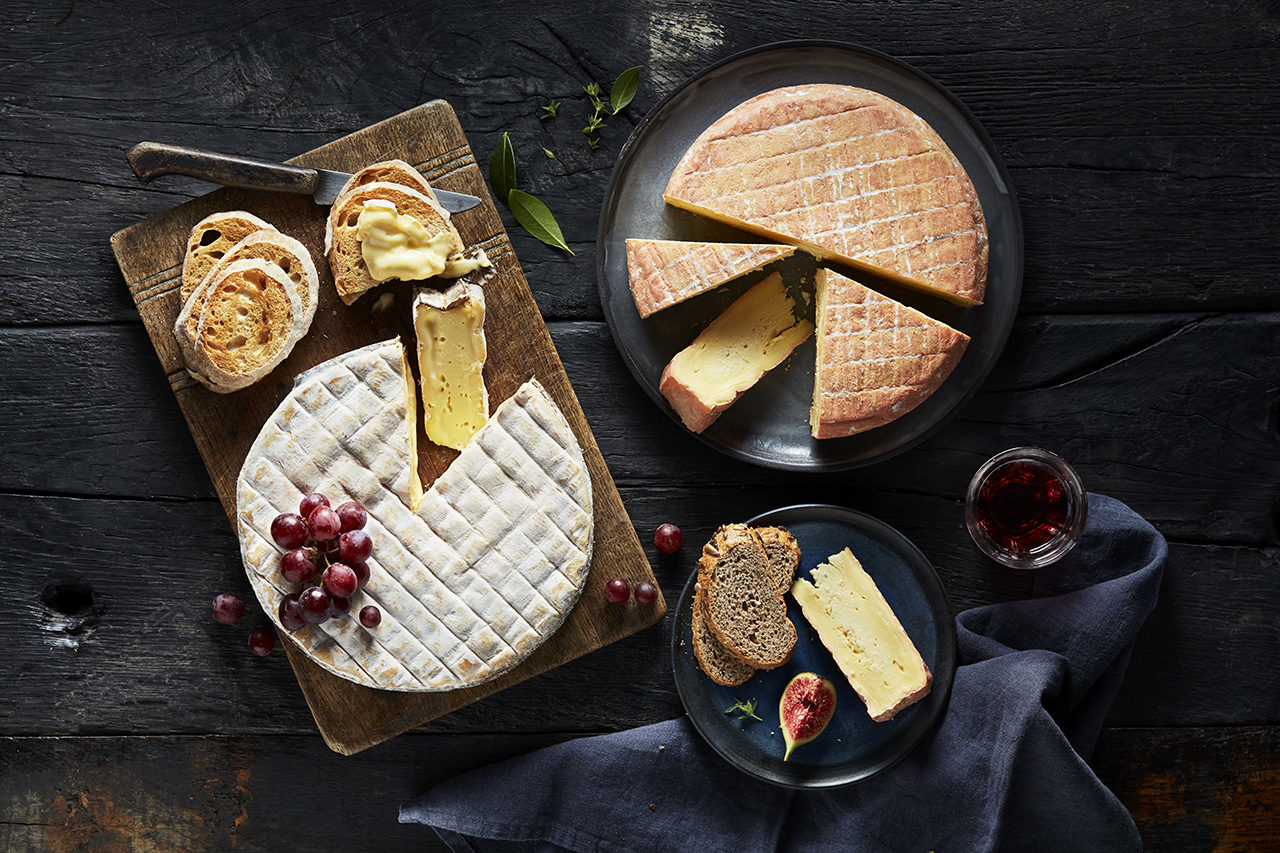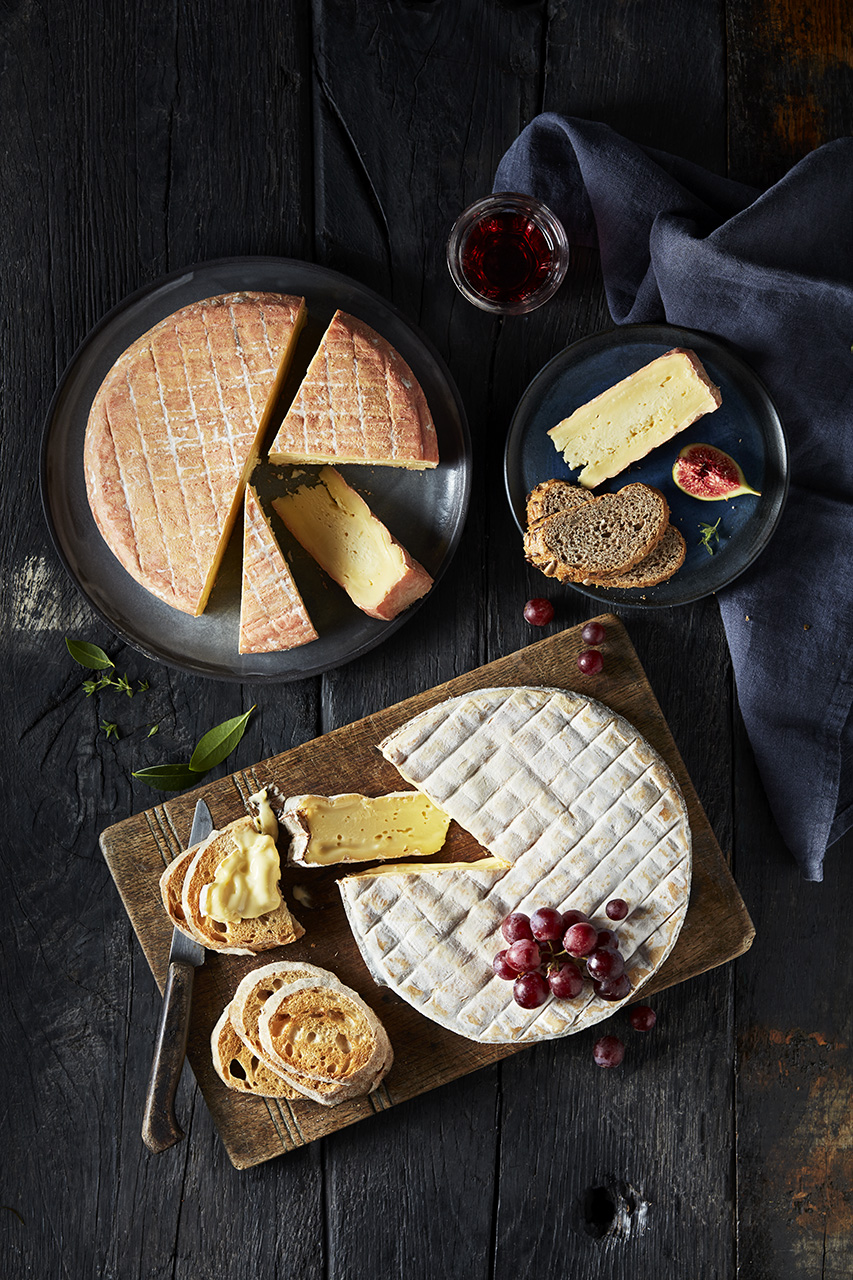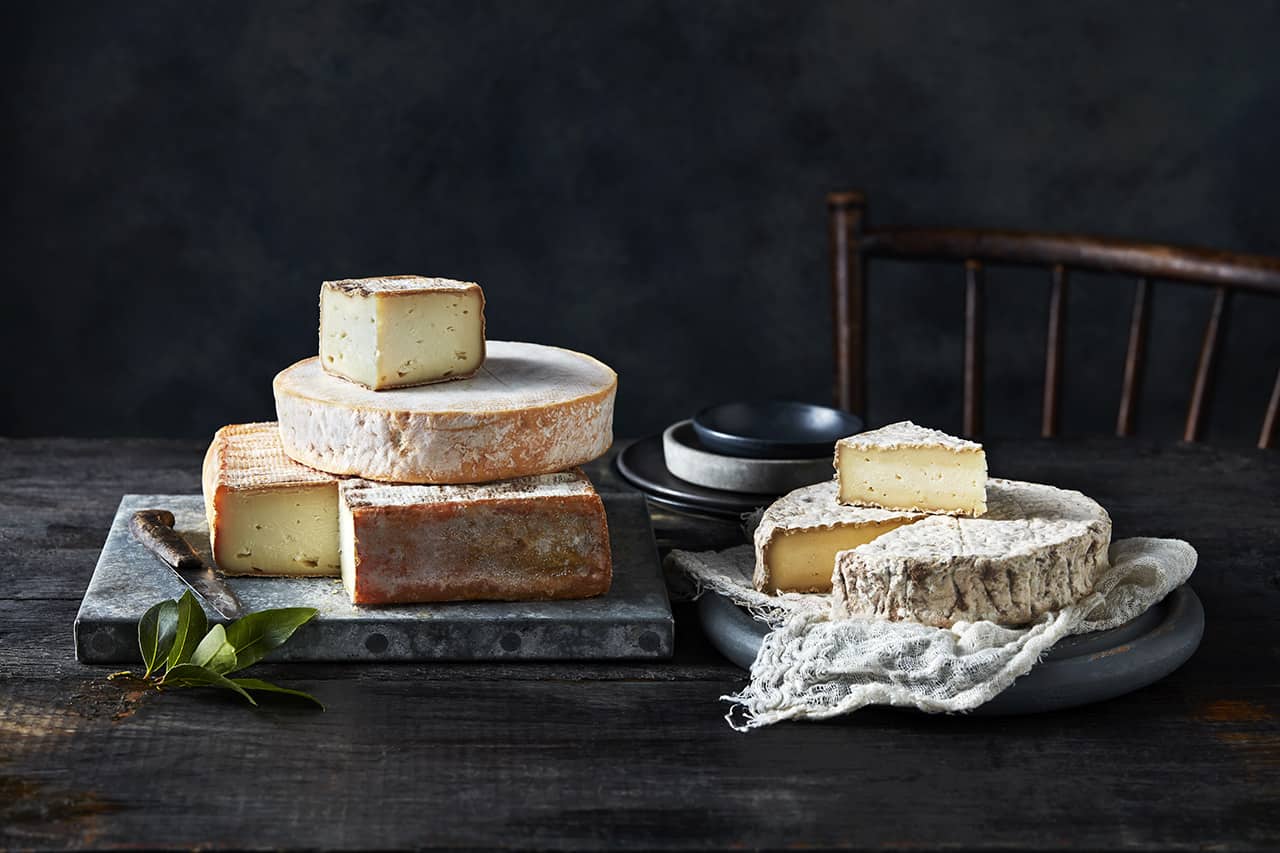
Photography by Danielle Wood | Food styled by Jenny White | Props styled by Cynthia Blackett
To make a surfing analogy, choosing to produce a washed rind as your first cheese is similar to taking beginner surfing lessons on the supersized Hawaiian wave known as Jaws. “What can go wrong?” muses Marcus Fergusson, a London music publicist turned artisan cheesemaker. “Everything.”
Fergusson should know. His Renegade Monk is a one-of-a-kind hybrid blue and ale-washed cheese, a technical undertaking that would make even the most experienced cheesemakers quiver. To top things off, he works in what he calls a cramped “experimental space”—essentially a souped-up lean-to attached to his Somerset farmhouse.
“There’s a flat roof above me so the temperature in the summer really builds up,” explains Fergusson, who began cheesemaking after only a one-day course. “Meanwhile the refrigeration is completely over-spec and the fans are really fierce which causes the cheeses to dry out or become too blue. I used the wrong sort of culture and molds to begin with…” He shrugs. “I’m in my third year of cheesemaking—it takes a lifetime to learn this stuff.”
Fergusson is almost as maverick as his cheese—the self-professed foodie put himself through the agony (and ecstasy) of creating such a rule-breaking wheel to simply “shake up the marketplace.” But he’s in good company. Over the past five years, a new wave of British cheesemakers has seized the washed-rind challenge—interesting for a country with, generally speaking, a historic aversion to producing washed-rind soft cheese.
Holy Odors
While the term “washed rind” can be applied extremely broadly—the firm Alpine wheel Comté, for example, falls within the category—the designation is owned by those pungent soft and semi-soft cheeses of a lurid tangerine hue, their sticky rinds concealing a glistening ivory or cream interior that’s often on the brink of bursting its microbe-encrusted banks.
Although details are scarce, history’s washed-rind eureka moment is generally bestowed upon a Benedictine monk toiling in the Maroilles Abbey of Northern France circa 960 A.D. With meat consumption in stricter monasteries reserved for the sick or a smattering of annual feast days, the incentive to develop a satisfying alternative was high.
Frequently doubling as boutique breweries, monasteries allowed inventive monks the capacity to experiment. Rinds were washed—by brush or by hand (the latter method is known as smear-ripening)—with whatever ale, perry, or brandy was available. Regular washes helped prevent the rind from drying out while also encouraging bacteria (Brevibacterium linens, in particular) that preferred the more humid, saltier conditions, ripening the cheese from the outside in and producing an appealing—if funky—orange rind. Certain washes delivered sumptuous flavors both within the cheese and on the edible rind, often with that yearned-for-meatiness—Époisses de Bourgogne, hand washed in Marc de Bourgogne, is a classic example.
When the Cistercians packed up their spare cassocks and made for medieval Britain and Ireland, no doubt their washed-rinds would have come too, but little is known about the technical details. Fast forward to the twentieth century, and the style had little presence in and around British shores—until a flourishing of washed-rind cheeses in the south of Ireland emerged in the 1970s.
Bronwen Percival, author of Reinventing the Wheel (University of California Press, 2017) and cheese buyer for Neal’s Yard Dairy in London, picks up the story. “By the early ’80s, [Irish cheesemaker] Veronica Steele had generated a farmhouse cheese culture that hadn’t existed in Ireland for a very long time. It gave rise to a whole collection of washed-rind cheeses in West Cork, essentially becoming a regional style.”
The most famous of these include Milleen’s (made bySteele at Milleen’s Cheese), Durrus, and the discontinued Ardrahan. Back in Blighty, efforts to wash rinds were sporadic, less part of any larger pattern. Perry-washed Stinking Bishop—inspired by the Cistercians who once farmed cheesemaker Charles Martell’s land—emerged in the early 1970s (burnishing its stinky credentials in 2009, when it was described as smelling like a “rugby club changing room” after winning Britain’s Smelliest Cheese Championships). And then there was the accidental affineur and washed-rind enthusiast James Aldridge, a former builder who fell off his ladder and landed a place in British cheese history.
Cheesemonger Andy Swincoe of The Courtyard Dairy explains that Aldridge’s experimentation with rinds began during a Christmas cheese rush at his wife’s deli. Storing the Stilton (a blue cheese) too close to the Caerphilly (a hard, crumbly wheel) in the cramped cellar, he noted that the Stilton had transferred some of its sticky orange bacteria to the rind of the Caerphilly. Intrigued by the potential, Aldridge began to experiment with washes, ultimately producing a number of notable examples including a wine-washed Caerphilly named Tornegus.
Still, it wasn’t until the last five years or so that creative cheesemakers began filling out the British washed-rind cheese shelf—and winning top awards along the way. Take Blackwoods Cheese Company Edmund Tew, for instance—the Petit Langres–style washed rind (named fora deported cheese thief) stole Supreme Champion at the 2018 Artisan Cheese Awards. Or the pungent, spoonable St. Cera by White Wood Dairy, which spirited away the James Aldridge Memorial Trophy for the Best British Raw-Milk Cheese in 2016. And in the same year, Rollright—a creamy Vacherin du Haut-Doubs–style produced by David Jowett of King Stone Dairy—was crowned the Artisan Cheese Awards’ Supreme Champion (the first of many accolades for this four-year-old cheese).
So what sparked this sticky-rind insurgency? Swincoe points to the reduced costs in making a soft cheese (quicker stock turnover, less equipment required), while Percival attributes the washed-rind groundswell to an increased level of technical control.
“Take David Jowett,” she says of the Oxfordshire-based cheesemaker. “What’s impressive about Rollright is that from the beginning it has been very polished, nicely presented, every bit as beautiful as a French Vacherin. Even compared to when I started working at Neal’s Yard 14 years ago, there’s a level of polish that wasn’t common in the British cheese industry at the time.”
Wash On, Wash Off
A bright round of Rollright, smaller than my hand, sits on the table before me (beside it squats its angry orange twin—we’ll get to that in a minute). The Rollright is immaculate, a sprung mattress of a cheese, its buttercup-yellow paste enclosed within a peachy-white latticed rind, bound by a spruce cummerbund. I’m in Jowett’s small dairy on King Stone Farm, surrounded by the rolling Cotswold countryside—only a few hundred yards from the Neolithic Rollright stones that give the cheese its name.
“Turns out Vacherin-style is a finicky cheese to get right,” says Jowett, a sparky 20-something. In explaining why, like Fergusson, he decided on trial-by-washed-rind for his first solo cheese, Jowett doesn’t cite commercial pragmatism or a young cheesemaker’s technical ambitions. Instead he mentions Christmas.
“When I started working at [cheese shop Paxton &Whitfield] in 2007, we had a lot of Vacherin in store…” he gives a gluttonous chuckle, “very difficult to order Vacherin stocks correctly. It was the first cheese I fell in love with and that was what I wanted to make.”
Rollright isn’t simply a Vacherin du Haut-Doubs copy. It carries less moisture than the French classic, while the curd is cut smaller, more like Reblochon (another European washed-rind grande dame). After the cheese freely drains, it’s carefully brushed with brine for four washes to help achieve that “nice Vacherin frosting.” Jowett describes how the pH of the cheese is too low to allow B. linens to find a foothold. The knowledgeable cheesemaker—a graduate of the UK’s School of ArtisanFood—pushes gently on the rind to show the delicate layering of intentional yeasts, the peachy color beneath the white Geotrichum bloom.
I relay something to Jowett that Percival has said. While there are obvious differences between Stinking Bishop and Rollright, philosophically they’re similar in how they draw inspiration from continental Europe’s cheeses. He acknowledges the point, and it’s then that we move to Rollright’s angry twin—Evenlode—which he’s been producing since last year. I take a slice and savor the brothy, beefy notes and the cheese’s spritzy lactic core.
Someone apparently told him that Evenlode, in looks, resembled Ardrahan—the now discontinued Irish washed rind. However Jowett’s recipe isn’t derivative—it’s born of his tinkering and intuition, and offers something more original, with an acidity more in line with the crumbly territorial cheeses of the north, like Cheshire or Lancashire.
Saints Alive
Mountainous Cumbria lies to the north of the county of Lancashire. It’s a land of lakes and wet sheep, Peter Rabbit, and Holker Farm—the 20 acres of pasture where St. James cheese is produced. If Renegade Monk and Evenlode are stylistic originals surfing this washed rind new wave, then the raw sheep’s milk St. James, Percival suggests, represents an even greater step towards originality.
“St. James is asking, What does this farm produce? and How can I manipulate the environment to privilege the right bacteria?,” she adds. “Everything that is used to sour the milk and ripen the cheese is from the milk and the farm itself, rather than commercially produced. The only other one that I can think of that is in that category is [the late Mary Holbrook’s goat’s milk washed rind], Cardo.”
St. James is named for James Aldridge. Cheesemaker Martin Gott laughs as he recalls a story about how Aldridge, who worked with his father, named a cheese “Brother David” because, as Aldridge put it, “My wife’s brother, David, liked it.”
Gott’s a fan of originality, whether sought out or serendipitous. The origins of St. James lie somewhere in between: In 2005, following the recipe for a Lancashire—the only cheese he knew how to make—but lacking a curd mill to finish the process, he and his partner, Nicola, progressed the cheese as far along as they could. Afterwards, on a whim, Martin sent the truncated Lancashire to Neal’s Yard Dairy to see what rind washing might achieve and—presto—a modern classic was born (actually, make that two modern classics: the success of St. James inspired Martin’s mentor Holbrook to develop Cardo).
Over time, Martin has become increasingly committed to having his cheese fully express the raw milk produced by his herd of Lacaune sheep. A few years ago, feeling as if the starter cultures they were buying weren’t representative of the cheese they wanted to make, the Gotts began playing around with cultures developed from the milk of their best ewes. “We expected a lot of weirdness and crazy flavors, but bizarrely the cheese became less weird—it tasted more like itself,” he recalls.
St. James is hand-washed with a brine solution three times a week. The Gotts try to rub off any wild molds that grow on the exterior, although Martin says that the molds’ persistence means that the rind can sometimes resemble a resprayed car, with blues or greens layered beneath the orange.
The flavor and texture varies with the seasons, but is often savory and meaty, rich and creamy, with a rind offering bacon notes. Martin is dedicated to his method, believing that truly unique, world class cheeses require dependence on a single farm’s raw milk supply.
But whatever the provenance, the genie is truly out of the bottle for British washed rinds. Jowett is moving addresses, scaling up to meet demand. Back in Somerset, Fergusson is doing the same, fleeing the flat roof and fierce fans of his past and constructing a 2,066-square-foot dairy on his smallholding, with space for the production of at least two other cheeses besides Renegade Monk.
Will he do another washed rind? Apparently, I’m not the first to ask—he’s been encouraged to use cider this time, as he’s based in Somerset after all. “I’m pretty determined not to do another,” he laughs, before reminiscing about how umami and delicious an experimental stout-washed Monk was. “Never say never,” he self-corrects.
Tasting Notes
Cardo
Sleight Farm, Somerset, England, Raw goat’s milk
Using rennet derived from Portuguese thistles, the dry, pinkish-white rind gives way to a glossy paste offering a floral flavor and a chalkier, curdier core.
Renegade Monk
Feltham’s Farm, Somerset, England, Pasteurized cow’s milk
Within this hybrid blue/ale-washed cheese’s plaster-white, brainy rind is a chalky, ivory core that’s full-flavored with floral and barnyard notes.
Rollright
King Stone Dairy, Oxfordshire, England, Pasteurized cow’s milk
A creamy, buttery cheese with a silky yellow paste. Smoky, piney notes begin to leech in from the spruce as the cheese ages.
Evenlode
King Stone Dairy, Oxfordshire, England, Pasteurized cow’s milk
The beefy, brothy flavors of this tangerine-hued wheel conceal a fresh, lactic core.
St. James
Holker Farm, Cumbria, England, Raw sheep’s milk
A semi-soft ivory paste with a fresh citrus bite gives way to a nutty finish, all encased in a savory rind.
Maida Vale
Village Maid Cheese, Berkshire, England, Thermalized cow’s milk
This rich, earthy cheese carries hoppy notes from the IPA with which it’s washed.
Edmund Tew
Blackwoods Cheese Company, Kent, England, Raw cow’s milk
Malty notes on the cheese’s wrinkly Geotrichum rind complement a fresh lactic paste within.
St. Cera
White Wood Dairy, Suffolk, England, Raw cow’s milk
Regular spraying and brushing with brine produces a fluid, intensely flavored cheese.








Hi Chris,
Thank you for a great and informative article.
I learnt more about my local washrinds here than anywhere else and will be looking to put some of the Cheeses on the list here at The Little Wine Shop & Social.
Look forward to reading some more of your work.
Max